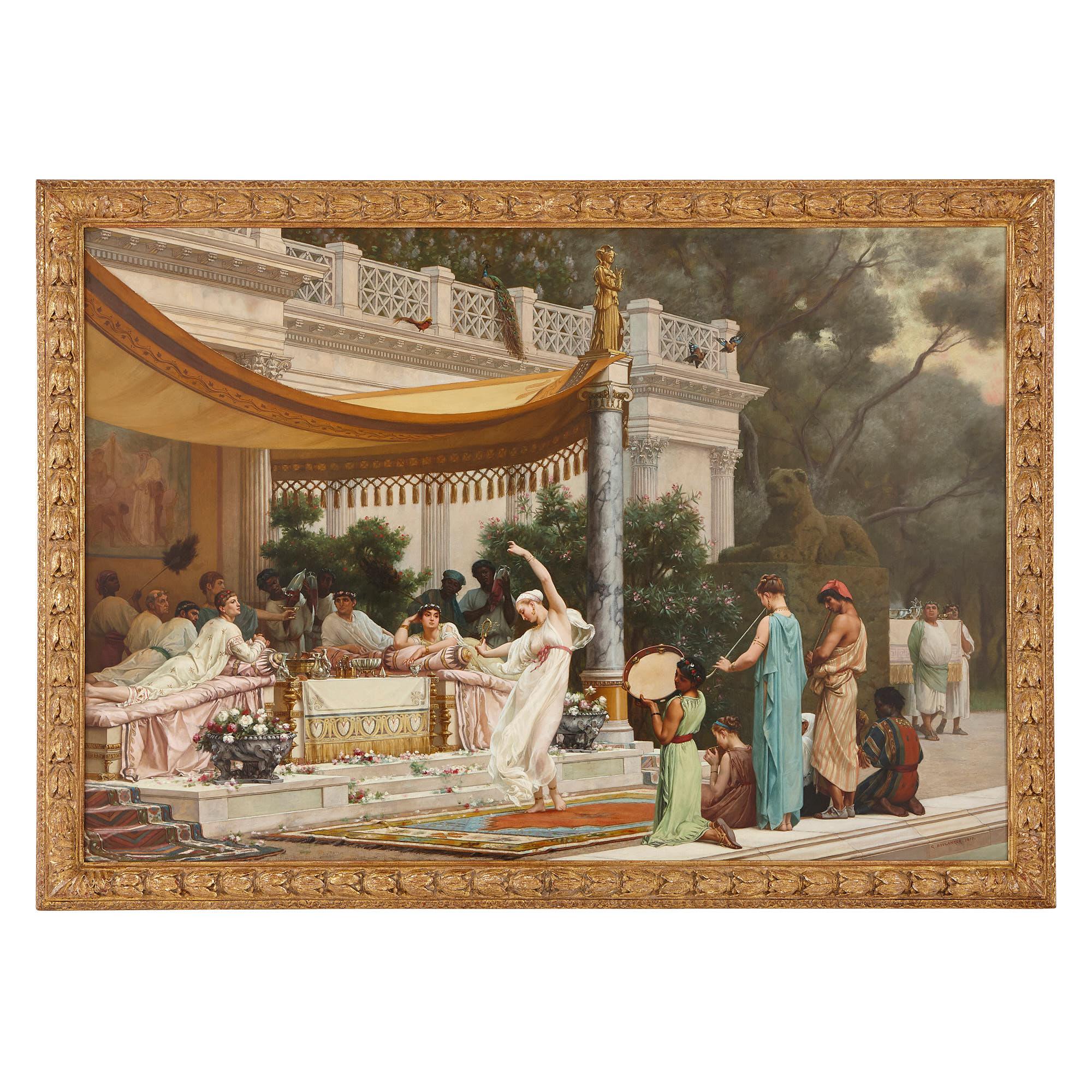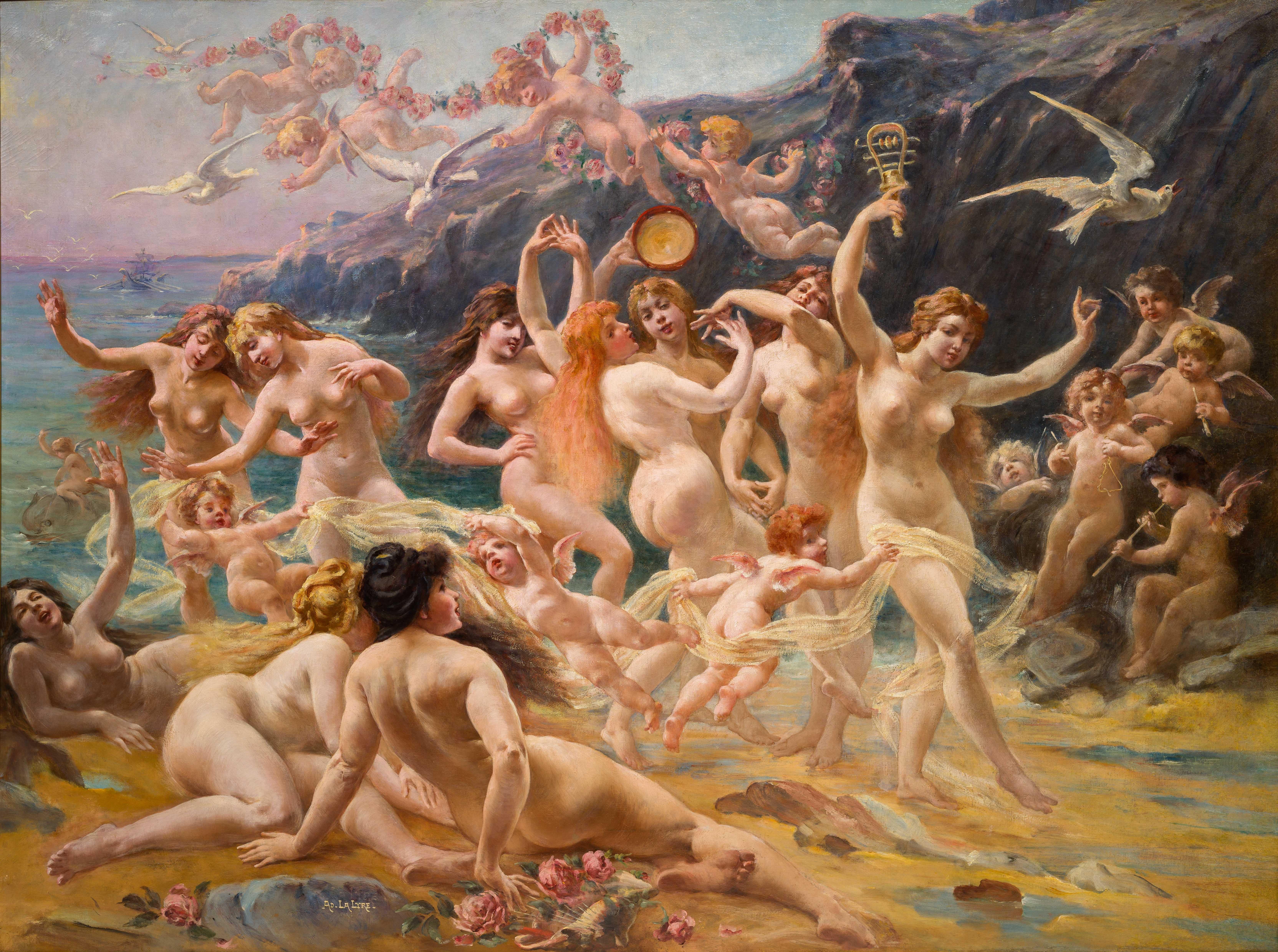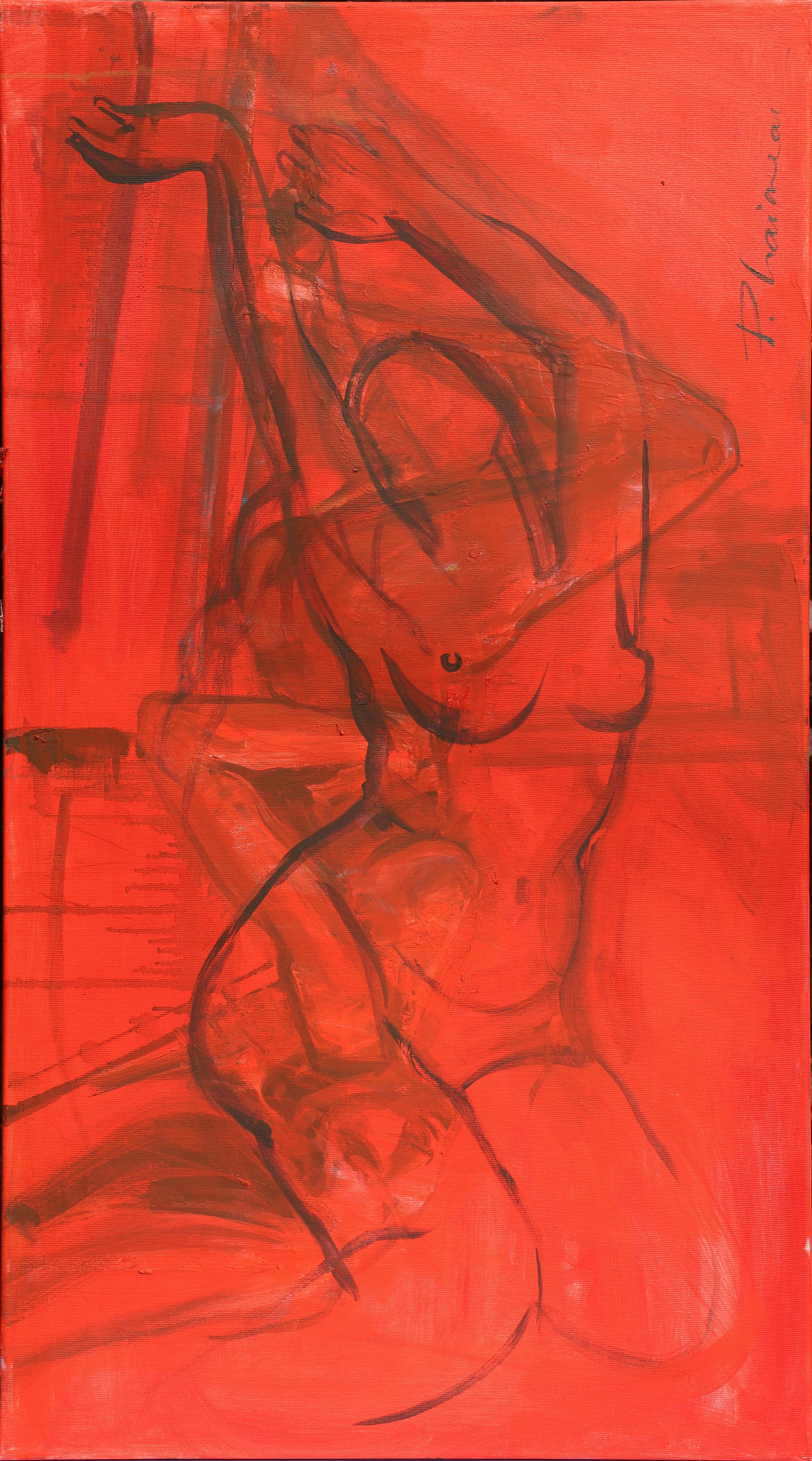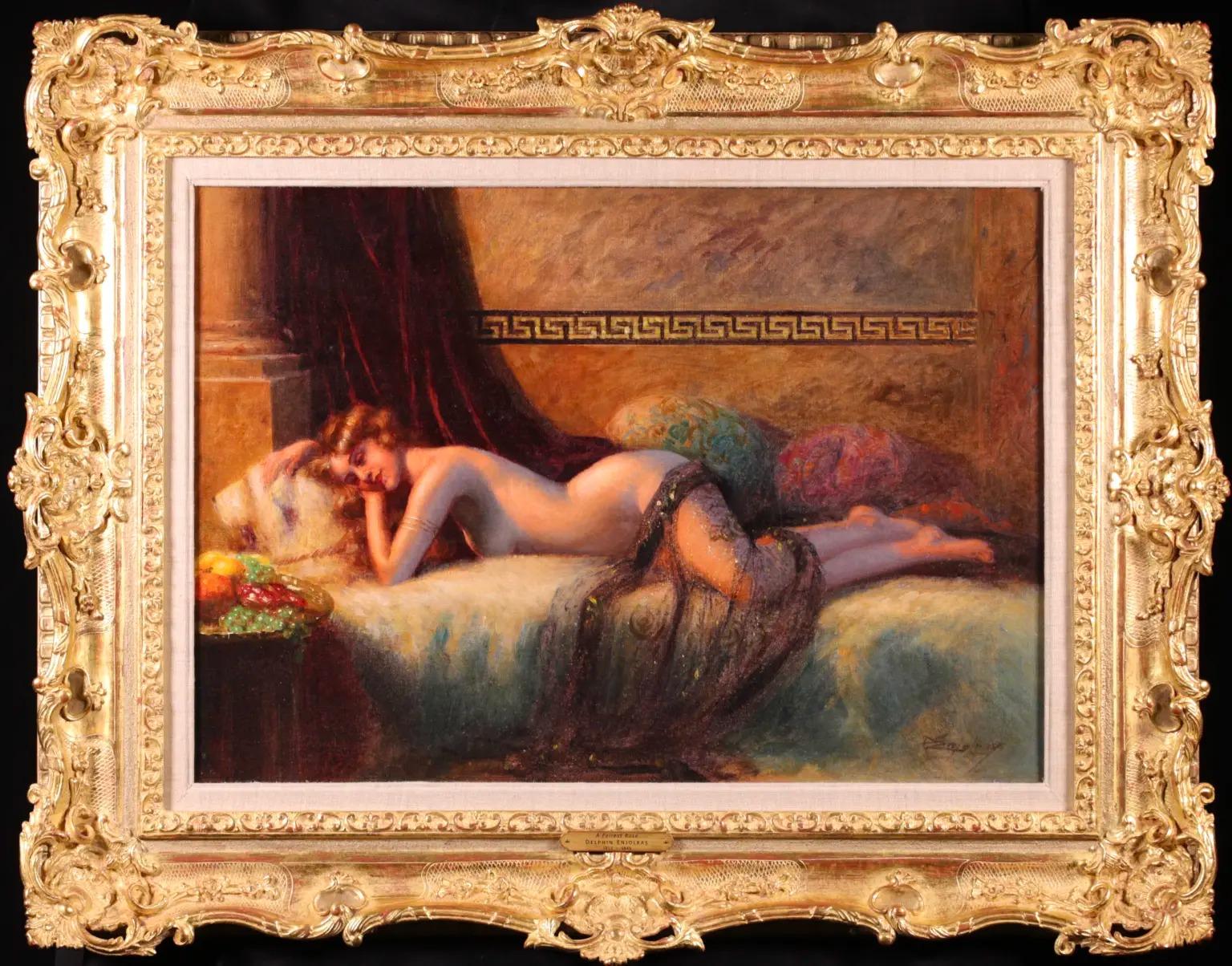Items Similar to The gift of flowers
Video Loading
Want more images or videos?
Request additional images or videos from the seller
1 of 11
Conrad KieselThe gift of flowersc. 1900
c. 1900
About the Item
Conrad Kiesel (1846-1921), The gift of flowers. Oil on wood, 43 x 35 cm, 69 x 61 cm (frame), signed at lower left "Conrad Kiesel pxt [pinxit]", about 1900. In a magnificent gilt stucco frame of the period. With an old London gallery label on the reverse.
- Major retouching by the artist himself to lighten the incarnate. The painting is in very good condition, the frame partially rubbed and bumped.
- The depth of allegory -
At first glance, Conrad Kiesel illustrates Flora, the goddess of blossom and spring, and yet the figure depicted does not fit into the traditional iconography. Flora has neither black hair nor does she wear a laurel wreath. Based on traditional imagery, Conrad Kiesel creates a novel allegory that includes eros, death, and the triumph of art over death alongside the unfolding of life.
The flowers illustrate the blossoming life whose beauty is before our eyes in the young woman. The flowers seem to formally turn towards her, and her antiquing gray-blue robe has a folded structure related to the flowers, so that it in turn seems like a calyx of blossoms from which the youthful beauty emerges. The garment not only allows a view of her upper arm, which animates the imagination of the shoulder and the tracing of the elegant neck line, where the two pink chrysanthemums 'look' at the youthful beauty, the garment is translucent, so that her breast becomes visible in a game of concealment and revelation.
The blossoming life imbued with Eros is contrasted by the black hair and dark eye sockets, allegorically introducing the dimension of death into the motif. But the young woman is also crowned with the laurel wreath of eternal glory, so that the flora becomes Victoria, illustrating that glory overcomes death. At the same time, the laurel wreath is also a symbol of poetry, making the young woman the personification of poetry and inspiration, as well as a muse. Consistent with this aspect of eternity, which refers to art itself, the yellowish background appears like a golden ground, against which the young woman appears like a saint.
Conrad Kiesel was especially sought after as a portraitist. In this painting, in which he did not follow a portrait commission, he had the freedom to follow his own pictorial ideas completely. He created a multi-layered allegory whose mysterious appeal lies in the fact that it cannot be definitively resolved.
The painting is an excerpt and allegorical intensification of his picture 'Die Margareten' in the Manchester Art Gallery, which in variation was also converted into painting by the Königliche Porzellan-Manufaktur (KPM).
While the oriental beauty is hawking the flowers there, the young woman in our picture takes two yellow flowers from the bouquet with an elegant gesture in order to offer them to the one whom her gaze has chosen and whose name her sensually open mouth already seems to pronounce.
The change from oriental beauty to allegory explains the retouching done to lighten the incarnate. This sensitivity to color is also evident in the decision to have the young woman remove two yellow flowers from the otherwise pink bouquet. Combined with the gray-blue of the garment, this creates a subtle, well-balanced tension of color.
About the artist
Conrad Kiesel first studied architecture at the Royal Academy of Architecture in Düsseldorf, but then transferred to the Berlin Academy of Arts to study sculpture with Fritz Schaper. After working as a sculptor for six years, he decided to become a painter, inspired by a trip to Holland. He was first a student of Fritz Paulsen in Berlin, then moved to Düsseldorf to study under Wilhelm Sohn.
"With Wilhelm Sohn he acquired colouristic skills which he quickly developed to the highest virtuosity, namely in the treatment of shiny silk and atlas fabrics".
Adolf Rosenberg
After a stay in Munich, Conrad Kiesel settled in Berlin in 1885 and became a sought-after society and portrait painter in the highest circles. He painted portraits of Wilhelm II and the Empress Augusta. In 1886 he was appointed Royal Professor.
He was awarded the gold medal several times at the exhibitions of the Berlin Academy. His works were regularly exhibited at the Academy exhibitions in Düsseldorf and Vienna and at the Glass Palace in Munich. Internationally, he exhibited at the Royal Academy of Arts and was represented in 1910 at the Paris, and 1911 at the Roman World's Fair.
GERMAN VERSION
Conrad Kiesel (1846-1921), The gift of flowers. Oil on wood, 43 x 35 cm, 69 x 61 cm (frame), signed at lower left "Conrad Kiesel pxt [pinxit]", about 1900. In a magnificent gilt stucco frame of the period. With an old London gallery label on the reverse.
- Major retouching by the artist himself to lighten the incarnate. The painting is in very good condition, the frame partially rubbed and bumped.
- The depth of allegory -
At first glance, Conrad Kiesel illustrates Flora, the goddess of blossom and spring, and yet the figure depicted does not fit into the traditional iconography. Flora has neither black hair nor does she wear a laurel wreath. Based on traditional imagery, Conrad Kiesel creates a novel allegory that includes eros, death, and the triumph of art over death alongside the unfolding of life.
The flowers illustrate the blossoming life whose beauty is before our eyes in the young woman. The flowers seem to formally turn towards her, and her antiquing gray-blue robe has a folded structure related to the flowers, so that it in turn seems like a calyx of blossoms from which the youthful beauty emerges. The garment not only allows a view of her upper arm, which animates the imagination of the shoulder and the tracing of the elegant neck line, where the two pink chrysanthemums 'look' at the youthful beauty, the garment is translucent, so that her breast becomes visible in a game of concealment and revelation.
The blossoming life imbued with Eros is contrasted by the black hair and dark eye sockets, allegorically introducing the dimension of death into the motif. But the young woman is also crowned with the laurel wreath of eternal glory, so that the flora becomes Victoria, illustrating that glory overcomes death. At the same time, the laurel wreath is also a symbol of poetry, making the young woman the personification of poetry and inspiration, as well as a muse. Consistent with this aspect of eternity, which refers to art itself, the yellowish background appears like a golden ground, against which the young woman appears like a saint.
Conrad Kiesel was especially sought after as a portraitist. In this painting, in which he did not follow a portrait commission, he had the freedom to follow his own pictorial ideas completely. He created a multi-layered allegory whose mysterious appeal lies in the fact that it cannot be definitively resolved.
The painting is an excerpt and allegorical intensification of his picture 'Die Margareten' in the Manchester Art Gallery, which in variation was also converted into painting by the Königliche Porzellan-Manufaktur (KPM).
While the oriental beauty is hawking the flowers there, the young woman in our picture takes two yellow flowers from the bouquet with an elegant gesture in order to offer them to the one whom her gaze has chosen and whose name her sensually open mouth already seems to pronounce.
The change from oriental beauty to allegory explains the retouching done to lighten the incarnate. This sensitivity to color is also evident in the decision to have the young woman remove two yellow flowers from the otherwise pink bouquet. Combined with the gray-blue of the garment, this creates a subtle, well-balanced tension of color.
About the artist
Conrad Kiesel first studied architecture at the Royal Academy of Architecture in Düsseldorf, but then transferred to the Berlin Academy of Arts to study sculpture with Fritz Schaper. After working as a sculptor for six years, he decided to become a painter, inspired by a trip to Holland. He was first a student of Fritz Paulsen in Berlin, then moved to Düsseldorf to study under Wilhelm Sohn.
"With Wilhelm Sohn he acquired colouristic skills which he quickly developed to the highest virtuosity, namely in the treatment of shiny silk and atlas fabrics".
Adolf Rosenberg
After a stay in Munich, Conrad Kiesel settled in Berlin in 1885 and became a sought-after society and portrait painter in the highest circles. He painted portraits of Wilhelm II and the Empress Augusta. In 1886 he was appointed Royal Professor.
He was awarded the gold medal several times at the exhibitions of the Berlin Academy. His works were regularly exhibited at the Academy exhibitions in Düsseldorf and Vienna and at the Glass Palace in Munich. Internationally, he exhibited at the Royal Academy of Arts and was represented in 1910 at the Paris, and 1911 at the Roman World's Fair.
- Creator:Conrad Kiesel (1846 - 1921)
- Creation Year:c. 1900
- Dimensions:Height: 27.17 in (69 cm)Width: 24.02 in (61 cm)Depth: 3.15 in (8 cm)
- Medium:
- Movement & Style:
- Period:
- Condition:
- Gallery Location:Berlin, DE
- Reference Number:1stDibs: LU2438213065922

About the Seller
5.0
Vetted Seller
These experienced sellers undergo a comprehensive evaluation by our team of in-house experts.
Established in 2014
1stDibs seller since 2023
7 sales on 1stDibs
Typical response time: 7 hours
- ShippingRetrieving quote...Ships From: Berlin, Germany
- Return PolicyA return for this item may be initiated within 14 days of delivery.
More From This SellerView All
- Small Nude / - Abstract Figurativity -Located in Berlin, DEGustl Stark (1917 Mainz - 2009 ibid.), Small Nude, 1946. Oil on canvas, marouflaged, 54 x 25 cm (picture), 30 x 60 cm (frame), signed "Stark" top left, verso twice signed "Gustav Stark", inscribed by hand as "Small Nude" and dated by hand "1946". With label of the exhibition of the Bundeshaus Bonn from 1956. - Rubbed area in the lower third of the body, at the same level a retouch in the ochre background. I provisional frame. - Abstract Figurativity - About the artwork During the war, Gustl Stark suffered a particularly severe blow for an artist: he lost his right arm. Nevertheless, he continued to devote himself to art, and the painting, created in 1946, immediately after the end of the Nazi reign of terror, testifies to the dawn of a new era. At the same time, the work is a rare example of the artist's early figurative work, as Stark turned entirely to abstract painting as early as 1950. And even this painting is by no means purely figurative; rather, it already illustrates Stark's turn toward abstraction. We see a female nude, but one that remains faceless. This can be read symbolically and in relation to the immediate past epoch, which, in the face of horrors, silences and blinds - literally renders faceless. In this sense, the figure is positioned to 'look back'. But she does not look. While this meaning may resonate and make the painting an important work of the immediate postwar period, Gustl Stark is primarily concerned with something else here, namely art itself. The absence of the face leads to the body becoming something flat. Due to the de-individualization, we do not see a concrete person with his individual features, but a body surface. And indeed, the body is constructed through an extremely planar design. Even the contour lines that form the corporeality have a planar rather than a linear character, especially where they merge into shadow zones of almost the same color. And the surfaces themselves are not modeled. The incarnate parts do not show any plastic gradations; the corporeality is completely withdrawn into the plane, which is also true for the hair. In addition, there is no uniform background against which the figure could appear; rather, the area next to the hair is kept bluish, creating a succession of earth-toned colored areas, which again binds the figure to the surface. Last but not least, the flatness is also forced by the painting technique. Gustl Stark paints directly, a la prima, onto the coarse canvas, whereby the structure of the painting support remains visible in the picture, and in places - around the hair, for example - the canvas itself can be seen. This structural all-over lends the picture a certain flatness. Gustl Stark thus uses the very motif that stands for the corporeality of art par excellence - the female nude - to transform the spatiality of the traditional picture into a flatness characteristic of modern art. And yet, a strong impression of corporeality is created, without being produced by a painterly modeling of the body. The oscillation between flatness and corporeality creates the intense tension of this groundbreaking painting. In Gustl Stark's oeuvre, as a consequence of the abstraction we see here, the figurative is completely stripped away in a further step, which is also a loss when looking at this early key work. About the artist Gustl Stark was the son of a woodcarver and, after an apprenticeship as a decorative painter, attended the State School of Arts and Crafts in Mainz from 1936 to 1937. Although he was severely wounded in the war and lost his right arm, he studied at the Würzburg School of Painting and Drawing from 1943-1944 and then at the Academy of Fine Arts in Nuremberg from 1944-1948. He won a state scholarship at the state art competition in Bad Ischl. Numerous study trips to Sylt, Paris, Switzerland, Austria, Italy, Holland and Belgium followed. Gustl Stark worked in Mainz and was the first artist there to focus on abstract painting. His work quickly gained international recognition, including the Salon Réaliés Nouvelles in Paris. From 1963-1970 he taught at the State University Institute for Art and Work Education in Mainz and from 1970-1975 at the Johannes Gutenberg University. Gustl Stark became particularly famous for his color embossed prints, for which he invented his own technique. Gustl Stark received numerous awards for his work. He received the Art Prize for Painting of the City of Mainz in 1962, the State Prize of Rhineland-Palatinate in 1984, and the Gutenberg Bust of the City of Mainz in 1987. Selected Bibliography Hans Vollmer (Hrsg.): Allgemeines Lexikon der bildenden Künstler des XX. Jahrhunderts, Vierter Band, Leipzig 1958, S. 344. Hans H...Category
1940s Realist Nude Paintings
MaterialsCanvas
- Two countrywomen with a donkey - Melancholy in an atmosphere of colour -Located in Berlin, DEPierre Louis De La Rive (1753 Geneva - 1817 Geneva). Two countrywomen with a donkey. Oil on canvas, mounted, 27 x 20 cm (visible size), 37 x 31 (frame), monogrammed "P.R." at lower right. About the artwork De La Rive has taken the typical scenes of Dutch landscape genre paintings...Category
1790s Old Masters Figurative Paintings
MaterialsCanvas, Oil
- Autumn Landscape in Sunlight - Indian Summer -Located in Berlin, DEFrederick Vezin (1859 Torresdale Philadelphia - 1933 Düsseldorf), Autumn Landscape in the Sunlight, oil on canvas, mounted on cardboard, 32 x 41 cm (inside measurement), 44 x 51 cm (...Category
Early 1900s Impressionist Landscape Paintings
MaterialsOil, Cardboard
- Half-length portrait of an elderly bearded man - Melancholy of a prophet -Located in Berlin, DEFriedrich August Seitz (1902 Staffort - 1944 Belgrade). Half-length portrait of an elderly man with a beard. Oil on canvas, 42 x 34 cm (visible seize), 58 x 50 cm (frame), signed and...Category
1920s Expressionist Figurative Paintings
MaterialsOil
- Landscape with Trees by a Lake - Eternal summer silence over an abysmal lake -Located in Berlin, DEAndreas Thomas Juuel (1816 Copenhagen - 1868 Copenhagen). Summer landscape with tall deciduous trees by a lake. Oil on canvas, 54,5 x 42 cm (visible size), 71 x 58 cm (frame), signed...Category
1850s Realist Landscape Paintings
MaterialsOil
- Children with geese in the light of a summer eveningLocated in Berlin, DEMagda Kremer (*1942 Hengelo), Children with geese in the light of a summer evening. Oil on canvas, 40 x 50 cm (inside measurement), 52 x 62 cm (frame), signed by hand with "M.[agda] ...Category
Mid-20th Century Realist Figurative Paintings
MaterialsOil
You May Also Like
- The Apparition - Large, Fine 1884 French Oil Painting - MAKE OFFERLocated in New Orleans, LAA stunningly dramatic and well-rendered oil on canvas painted by French artist Antoine Marie Roucole in 1884. With the ornate antique gilt plaster frame, and with its size, it has t...Category
1880s Academic Nude Paintings
MaterialsOil
- 'A Summer Repast at the House of Lucullus', large oil painting by BoulangerBy Gustave Clarence Rodolphe BoulangerLocated in London, GBThis beautiful painting was created in 1877 by the well-known French painter, Gustave Clarence Rodolphe Boulanger. Boulanger often produced work which combined the classical and Orie...Category
Late 19th Century Academic Figurative Paintings
MaterialsCanvas, Oil
- La Danse des SirènesBy Adolphe LalyreLocated in Paris, FRAdolphe LA LYRE 1850-1935 French "La danse des Sirènes" Oil on canvas Signed and dated lower left Painted in 1909 Canvas: 59" high x 78 3/4" wide Frame: 64"high x 84 5/8" wide ...Category
Early 20th Century Academic Nude Paintings
MaterialsOil, Canvas
- Echoes 2 - painting Paula Craioveanu oil on canvasBy Paula CraioveanuLocated in Forest Hills, NYEchoes 2 Composition with Two Female Nudes, oil on canvas, 35.5x19.5in / 90x50cm Part of WIngs of Gods, solo show. Shipped as it is, stretched, directly from the artist's studio.Category
2010s Academic Figurative Paintings
MaterialsCanvas, Oil
- Forest Nymph - Figurative Nude Oil Painting Colors Brown Grey Pale Blue GreenBy Lyubena FoxLocated in Sofia, BG"Forrest Nymph" (2016) Oil on canvas 80 x 100 cm unframed Painting was started in 2015, most of it was finished by 2016, the last touches done in 2019. Inspired by the 19th century French painter Bouguereau, she wanted to depict a nymph that inhibits the forest, wearing a flower crown made from Hepatica flowers, wild forest flowers. The Painting’s Qualities Lyubena Fox...Category
2010s Academic Figurative Paintings
MaterialsOil, Canvas
- Fairest Rose - French Academic Nude Oil Painting by Delphin EnjolrasBy Delphin EnjolrasLocated in Marlow, BuckinghamshireSigned nude in interior oil on canvas circa 1900 by French academic painter Delphin Enjolras. The piece depicts a red-haired nude resting on a bed in a lush boudoir with a sheer scar...Category
Early 20th Century Academic Nude Paintings
MaterialsCanvas, Oil





